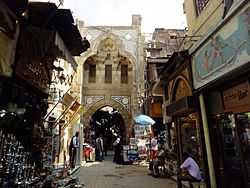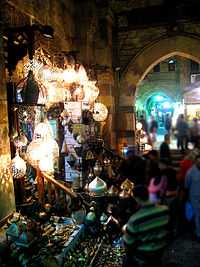Khan el-Khalili



Khan el-Khalili (Arabic: خان الخليلي) is a major souk in the Islamic district of Cairo. The bazaar district is one of Cairo's main attractions for tourists and Egyptians alike.
History
The site of Khan el-Khalili was originally the site of the mausoleum known as the turbat az-za'faraan (Saffron Tomb),[1] which was the burial site of the Fatimid caliphs.[2][3]:57 The mausoleum was part of the Fatimid Great Eastern Palace complex, begun in 970 CE by Gawhar al-Siqilli, the general who conquered Egypt for the Fatimid dynasty and founded Cairo that same year.[3]:56–57
By the time of Sultan Barquq, the first Circassian (or Burji) Mamluk Sultan in the late 14th century, Egypt had been significantly affected by the ravages of the Black Death but continued to be the center of great economic activity, and many commercial and religious buildings were constructed at this time.[3]:147 During Barquq's first reign (1382-1389), his Master of the Stables (amir akhur)[4]:179, the amir Jaharkas al-Khalili, destroyed the Fatimid cemetery to erect a large caravanserai (خان khan in Arabic; a building that could house merchants and their goods) at the heart of the city, disposing of the bones of the Fatimid royal family by throwing them into the rubbish hills east of the city.[3]:57
The khan was located at the middle of Cairo's most important zone of economic activity, and later sultans also built commercial establishments nearby, including Sultan Qaytbay's wikala (another term for caravanserai) south of the Al-Azhar Mosque, and Sultan al-Ghuri's better-preserved wikala just east of his mausoleum complex. This economic and commercial zone ran along the city's main north-south axis, the qasaba (now known as al-Mu'izz street), and was also the privileged site of many monumental religious complexes built throughout the Mamluk period and beyond.[3] By the late 15th century, the district around Khan el-Khalili had also become the major center of foreign trade, which included the sale of slaves and precious stones.[5]:62
Sultan al-Ghuri, Egypt's last important Mamluk sultan (1501-1517), modified the layout of the district through a major campaign of demolition and new construction. Along with his religious and funerary complex and a large wikala that still exist today, he demolished the original khan built by al-Khalili and rebuilt it in 1511 as a commercial complex with monumental gates and perpendicular streets, resembling the similar establishments in Ottoman cities where the most precious goods were sold.[3]:179 Among al-Ghuri's constructions was the Wikala al-Qutn ("of cotton"), parts of which are still visible today, including an ornate gate and upper stories whose external facade is lined with iron-grilled windows where merchants' rooms were located. Two other monumental gates, the Bab al-Badistan and the Bab al-Ghuri, also date from this time.[4]:179
From al-Ghuri's reign onwards, the district became associated with Turkish merchants, and during the Ottoman period the Turkish community of Cairo established itself here.[3]
-

The gate and remains of the Wikala al-Qutn, built by Sultan al-Ghuri in 1511.
Today
The Khan el-Khalili today is mainly occupied by Egyptian rather than foreign merchants and shopholders, but is significantly geared towards tourists. Shops typically sell souvenirs, antiques and jewellery, but many traditional workshops continue to operate in the surrounding area and the goldsmiths' souq, for example, is still important for locals.[4]:180[6]:81
In addition to shops, there are several coffeehouses (مقهى maqha ), restaurants, and street food vendors distributed throughout the market. The coffeeshops are generally small and quite traditional, serving Arabic coffee and usually offering shisha. One of the oldest and most famous coffehouses is Fishawi's, established in 1773.[6]:109
The al-Hussein Mosque is adjacent to Khan el-Khalili, and Al-Azhar University and its mosque are nearby.
In literature
Naguib Mahfouz's novel Midaq Alley (1947) is set in an alley in Khan el-Khalili.
Pivotal events of Neil Stephenson's novel The Confusion (2004), which is the second book of his The Baroque Cycle series, are set in the caravanserai within Khan el-Khalili.
Terrorist attacks
The market was a target of terrorism during the spate of attacks in Cairo in April 2005. The suicide attack in the market, on April 7, killed 21 people (eleven Egyptians, two French tourists, one American, and seven foreigners of unidentified origin). It was the first attack in the series; this attack drove away tourists from Egypt in general and Khan el-Khalili in particular for some time.
The market was again a target of terrorism on 22 February 2009. In this attack a 17-year old French girl was killed and 22 people were injured.
References
- ↑ Lev, Y. 2001. "Aspects of the Egyptian Society in the Fatimid Period". In Vermeulen, Urbain & J. van Steenbergen (eds.). Egypt and Syria in the Fatimid, Ayyubid, and Mamluk Eras III: Proceedings of the 6th, 7th and 8th International Colloquium Organized at the Katholieke Universiteit Leuven in May 1997, 1998, and 1999. Peeters Publishers. p. 20.
- ↑ Discover Islamic Art
- ↑ 3.0 3.1 3.2 3.3 3.4 3.5 3.6 Raymond, André. 1993. Le Caire. Fayard.
- ↑ 4.0 4.1 4.2 Williams, Caroline. 2008 (6th ed.). Islamic Monuments in Cairo: The Practical Guide. Cairo: American University in Cairo Press.
- ↑ Behrens-Abouseif, Doris. 2007. Cairo of the Mamluks: A History of Architecture and its Culture. Cairo: The American University in Cairo Press.
- ↑ 6.0 6.1 O'Neill, Zora et al. 2012. Lonely Planet: Egypt (11th edition).
| Wikimedia Commons has media related to Khan el-Khalili. |
External links
Coordinates: 30°02′51″N 31°15′44″E / 30.04750°N 31.26222°E